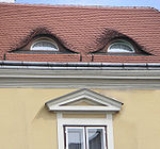
Hidden faces
Encyclopedia
People often see hidden faces in things. Depending on the circumstances, this is referred to as pareidolia
, the perception or recognition of a specific pattern or form in something essentially different. It is thus also a kind of optical illusion
. When an artist notices that two different things have a similar appearance, and draws or paints a picture making this similarity evident he makes images with double meanings. Many of these images are hidden faces or hidden skulls.
These illusionistic pictures present the viewer with a mental choice of two interpretations: head or landscape, head or objects, head or architecture, etc. Both of them are valid, but the viewer sees only one of them and very often he cannot see both interpretations simultaneously.
and the Man in the Moon
. Also Leonardo da Vinci
wrote about them in his notebook: "If you look at walls that are stained or made of different kinds of stones you can think you see in them certain picturesque views of mountains, rivers, rocks, trees, plains, broad valleys, and hills of different shapes. You can also find in them battles and rapidly moving figures, strange faces and costumes, as well as an infinite number of things." Francois and Jean Robert collected and published a lot of photos of "chance faces".


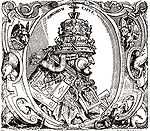
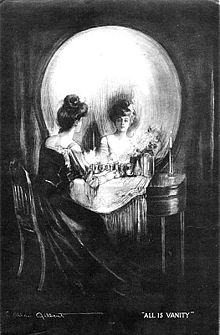 The Mannerist master at the 16th-century imperial Habsburg courts of Vienna and Prague, Giuseppe Arcimboldo
The Mannerist master at the 16th-century imperial Habsburg courts of Vienna and Prague, Giuseppe Arcimboldo
of Milan
was probably the best known artist for creating extraordinary hidden faces. He arranged flowers, vegetables, fruits, shells, scallops and other animals, books and different things on the canvas in such a way that the whole collection of objects formed a portrait. His series of The Four Seasons seems to be the first use of this approach and technique. Arcimboldo's composite heads were celebrated and imitated by his contemporaries but they were relatively forgotten until participants in the twentieth-century art movements rediscovered them, bringing them to the attention of art historians. He is considered as forerunner of Dada
and Surrealism
.
Some other famous Renaissance
and Baroque
artists created hidden faces like
Salvador Dalí
was fascinated by the technique of Arcimboldo and his paranoia-critical method was influenced by the Mannerist painter. For Dalí the Arcimboldo effect was form of self concealment as well as this exhibitionist painter seemed, all throughout his life of constant posturing, to hide his real self
behind the gaudy externals of his behaviour. Larvatus prodeo, "I wear a mask," he could have said with Descartes and he used this quotation from the French philosopher for the epigraph of his novel Hidden Faces. Probably his most famous "hidden face" is Voltaire
in his oil painting: Slave Market with the Disappearing Bust of Voltaire.
Other Surrealist painters rediscovered the technique of hidden faces in the first part of 20th century:
Istvan Orosz
tries to combine the technique of anamorphosis
with the hidden faces.
Anamorphosis is used for those works of art that were made as distorted and unrecognizable through clever geometrical constructions. But when viewed from a certain point, or through a reflecting object placed upon it, the hidden image appears in its true shape, that is, it goes through retransformation.
Orosz made experiments with anamorphoses not only in resurrecting the old technique but to improve and develop it. Instead of having a meaningless distorted image, his intent is to bring sense to the basic anamorphic picture, giving it meaning in itself with its second reading being revealed by viewing it from a different viewpoint such as looking at it through a special mirror.
The ambiguous layers coming up by this approach make use of the connection or contrast of the two images within the same picture being independent from each other.
There are many other contemporary works using hidden faces:
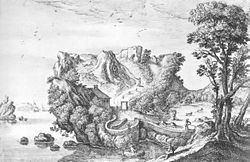
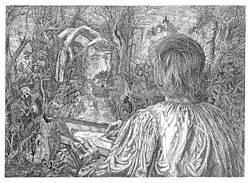
Pareidolia
Pareidolia is a psychological phenomenon involving a vague and random stimulus being perceived as significant. Common examples include seeing images of animals or faces in clouds, the man in the moon or the Moon rabbit, and hearing hidden messages on records played in reverse...
, the perception or recognition of a specific pattern or form in something essentially different. It is thus also a kind of optical illusion
Optical illusion
An optical illusion is characterized by visually perceived images that differ from objective reality. The information gathered by the eye is processed in the brain to give a perception that does not tally with a physical measurement of the stimulus source...
. When an artist notices that two different things have a similar appearance, and draws or paints a picture making this similarity evident he makes images with double meanings. Many of these images are hidden faces or hidden skulls.
These illusionistic pictures present the viewer with a mental choice of two interpretations: head or landscape, head or objects, head or architecture, etc. Both of them are valid, but the viewer sees only one of them and very often he cannot see both interpretations simultaneously.
Chance images
There are everyday examples of hidden faces, they are "chance images" including faces in the clouds, figures of the Rorschach TestRorschach test
The Rorschach test is a psychological test in which subjects' perceptions of inkblots are recorded and then analyzed using psychological interpretation, complex algorithms, or both. Some psychologists use this test to examine a person's personality characteristics and emotional functioning...
and the Man in the Moon
Man in the Moon
The Man in the Moon is an imaginary figure resembling a human face, head or body, that observers from some cultural backgrounds typically perceive in the bright disc of the full moon...
. Also Leonardo da Vinci
Leonardo da Vinci
Leonardo di ser Piero da Vinci was an Italian Renaissance polymath: painter, sculptor, architect, musician, scientist, mathematician, engineer, inventor, anatomist, geologist, cartographer, botanist and writer whose genius, perhaps more than that of any other figure, epitomized the Renaissance...
wrote about them in his notebook: "If you look at walls that are stained or made of different kinds of stones you can think you see in them certain picturesque views of mountains, rivers, rocks, trees, plains, broad valleys, and hills of different shapes. You can also find in them battles and rapidly moving figures, strange faces and costumes, as well as an infinite number of things." Francois and Jean Robert collected and published a lot of photos of "chance faces".
Hidden faces created by artists




Giuseppe Arcimboldo
Giuseppe Arcimboldo was an Italian painter best known for creating imaginative portrait heads made entirely of such objects as fruits, vegetables, flowers, fish, and books – that is, he painted representations of these objects on the canvas arranged in such a way that the whole collection of...
of Milan
Milan
Milan is the second-largest city in Italy and the capital city of the region of Lombardy and of the province of Milan. The city proper has a population of about 1.3 million, while its urban area, roughly coinciding with its administrative province and the bordering Province of Monza and Brianza ,...
was probably the best known artist for creating extraordinary hidden faces. He arranged flowers, vegetables, fruits, shells, scallops and other animals, books and different things on the canvas in such a way that the whole collection of objects formed a portrait. His series of The Four Seasons seems to be the first use of this approach and technique. Arcimboldo's composite heads were celebrated and imitated by his contemporaries but they were relatively forgotten until participants in the twentieth-century art movements rediscovered them, bringing them to the attention of art historians. He is considered as forerunner of Dada
Dada
Dada or Dadaism is a cultural movement that began in Zurich, Switzerland, during World War I and peaked from 1916 to 1922. The movement primarily involved visual arts, literature—poetry, art manifestoes, art theory—theatre, and graphic design, and concentrated its anti-war politics through a...
and Surrealism
Surrealism
Surrealism is a cultural movement that began in the early 1920s, and is best known for the visual artworks and writings of the group members....
.
Some other famous Renaissance
Renaissance
The Renaissance was a cultural movement that spanned roughly the 14th to the 17th century, beginning in Italy in the Late Middle Ages and later spreading to the rest of Europe. The term is also used more loosely to refer to the historical era, but since the changes of the Renaissance were not...
and Baroque
Baroque
The Baroque is a period and the style that used exaggerated motion and clear, easily interpreted detail to produce drama, tension, exuberance, and grandeur in sculpture, painting, literature, dance, and music...
artists created hidden faces like
- Leonardo da VinciLeonardo da VinciLeonardo di ser Piero da Vinci was an Italian Renaissance polymath: painter, sculptor, architect, musician, scientist, mathematician, engineer, inventor, anatomist, geologist, cartographer, botanist and writer whose genius, perhaps more than that of any other figure, epitomized the Renaissance...
- Albrecht DürerAlbrecht DürerAlbrecht Dürer was a German painter, printmaker, engraver, mathematician, and theorist from Nuremberg. His prints established his reputation across Europe when he was still in his twenties, and he has been conventionally regarded as the greatest artist of the Northern Renaissance ever since...
- Tobias StimmerTobias StimmerTobias Stimmer was a Swiss painter and illustrator. His most famous work is the paintings on the Strasbourg astronomical clock. He died in Strasbourg....
- Hans Holbein the YoungerHans Holbein the YoungerHans Holbein the Younger was a German artist and printmaker who worked in a Northern Renaissance style. He is best known as one of the greatest portraitists of the 16th century. He also produced religious art, satire and Reformation propaganda, and made a significant contribution to the history...
- Matthäus MerianMatthäus MerianMatthäus Merian der Ältere was a Swiss-born engraver who worked in Frankfurt for most of his career, where he also ran a publishing house.-Early life and marriage:...
- Anna Maria Sibylla Merian
- John Martin Will
- Henrich Göding
- Marcus Gheeraerts the ElderMarcus Gheeraerts the ElderMarcus Gheeraerts the Elder was a Flemish printmaker and painter associated with the English court of the mid-16th Century and mainly remembered as the illustrator of the 1567 edition of Aesop's Fables.-Biography:...
- Wenzel Hollar
- Henrich Ulrich
- Hans MeyerHans MeyerHans Meyer may refer to:*Hans Meyer , a South African actor, see Red Sonja *Hans Meyer , German geologist*Hans Meyer , German football manager and former player...
- Josse de Momper
Salvador Dalí
Salvador Dalí
Salvador Domènec Felip Jacint Dalí i Domènech, Marquis de Púbol , commonly known as Salvador Dalí , was a prominent Spanish Catalan surrealist painter born in Figueres,Spain....
was fascinated by the technique of Arcimboldo and his paranoia-critical method was influenced by the Mannerist painter. For Dalí the Arcimboldo effect was form of self concealment as well as this exhibitionist painter seemed, all throughout his life of constant posturing, to hide his real self
Real self
The Real self theory in politics and philosophy proposes that people often have a private "real will" , that is different from their public "expressed will".-References:...
behind the gaudy externals of his behaviour. Larvatus prodeo, "I wear a mask," he could have said with Descartes and he used this quotation from the French philosopher for the epigraph of his novel Hidden Faces. Probably his most famous "hidden face" is Voltaire
Voltaire
François-Marie Arouet , better known by the pen name Voltaire , was a French Enlightenment writer, historian and philosopher famous for his wit and for his advocacy of civil liberties, including freedom of religion, free trade and separation of church and state...
in his oil painting: Slave Market with the Disappearing Bust of Voltaire.
Other Surrealist painters rediscovered the technique of hidden faces in the first part of 20th century:
- Max ErnstMax ErnstMax Ernst was a German painter, sculptor, graphic artist, and poet. A prolific artist, Ernst was one of the primary pioneers of the Dada movement and Surrealism.-Early life:...
- René MagritteRené MagritteRené François Ghislain Magritte[p] was a Belgian surrealist artist. He became well known for a number of witty and thought-provoking images...
Istvan Orosz
István Orosz
István Orosz Hungarian painter, printmaker, graphic designer and animated film director, is known for his mathematically inspired works, impossible objects, optical illusions, double-meaning images and anamorphoses. The geometric art of István Orosz, with forced perspectives and optical...
tries to combine the technique of anamorphosis
Anamorphosis
Anamorphosis or anamorphism may refer to any of the following:*Anamorphosis, in art, the representation of an object as seen, for instance, altered by reflection in a mirror...
with the hidden faces.
Anamorphosis is used for those works of art that were made as distorted and unrecognizable through clever geometrical constructions. But when viewed from a certain point, or through a reflecting object placed upon it, the hidden image appears in its true shape, that is, it goes through retransformation.
Orosz made experiments with anamorphoses not only in resurrecting the old technique but to improve and develop it. Instead of having a meaningless distorted image, his intent is to bring sense to the basic anamorphic picture, giving it meaning in itself with its second reading being revealed by viewing it from a different viewpoint such as looking at it through a special mirror.
The ambiguous layers coming up by this approach make use of the connection or contrast of the two images within the same picture being independent from each other.
There are many other contemporary works using hidden faces:
- Bev Doolitte
- Shigeo FukudaShigeo Fukudawas a sculptor, graphic artist and poster designer who created optical illusions. His art pieces usually portray deception, such as Lunch With a Helmet On, a sculpture created entirely from forks, knives, and spoons, that casts a detailed shadow of a motorcycle....
- Octavio OcampoOctavio OcampoOctavio Ocampo was born on 28 February 1943 in Celaya, Guanajuato, Mexico. He grew up in a family of designers, and studied art from early childhood. At art school, Ocampo constructed papier mache figures for floats, altars, and ornaments that were used during carnival parades and other festivals....
- Sandro del PreteSandro del PreteSandro Del-Prete is a Swiss artist who paints figures, situations and processes that cannot exist in the real world. Del-Prete ‘materializes the well-known psychological effect, of the difference between ‘looking’ and ‘seeing’ ’ – Abraham Tamir...
See also


- AnamorphosisAnamorphosisAnamorphosis or anamorphism may refer to any of the following:*Anamorphosis, in art, the representation of an object as seen, for instance, altered by reflection in a mirror...
- Giuseppe ArcimboldoGiuseppe ArcimboldoGiuseppe Arcimboldo was an Italian painter best known for creating imaginative portrait heads made entirely of such objects as fruits, vegetables, flowers, fish, and books – that is, he painted representations of these objects on the canvas arranged in such a way that the whole collection of...
- Salvador DalíSalvador DalíSalvador Domènec Felip Jacint Dalí i Domènech, Marquis de Púbol , commonly known as Salvador Dalí , was a prominent Spanish Catalan surrealist painter born in Figueres,Spain....
- Anna Maria Sibylla Merian
- Optical illusions
- Istvan OroszIstván OroszIstván Orosz Hungarian painter, printmaker, graphic designer and animated film director, is known for his mathematically inspired works, impossible objects, optical illusions, double-meaning images and anamorphoses. The geometric art of István Orosz, with forced perspectives and optical...
- PareidoliaPareidoliaPareidolia is a psychological phenomenon involving a vague and random stimulus being perceived as significant. Common examples include seeing images of animals or faces in clouds, the man in the moon or the Moon rabbit, and hearing hidden messages on records played in reverse...
- Rubin vaseRubin vaseRubin's vase is a famous set of ambiguous or bi-stable two-dimensional forms developed around 1915 by the Danish psychologist Edgar Rubin...
- UtiszUtiszOutis is an often used pseudonym. Artists, writers and others in public life use this pseudonym in order to hide their identity.- Origin of the name :...
Literature
- Calabrese, Omar (2006): Artists' Self-Portraits, ISBN 9780789208941 (The book has a chapter on artists who hide self portraits in their pictures: e.g. Leonardo da Vinci, Michelangelo, Rembrandt, van Gogh, Munch, Dali, Albrecht Dürer, Velàzquez, Elisabeth Vigée-Lebrun, Ingres, Degas, Toulouse-Lautrec, Gainsborough, Matisse, James Ensor, Egon Schiele, Frida Kahlo, Man Ray, Henry Moore, Robert Rauschenberg, Norman Rockwell, and Roy Lichtenstein.)
- Martin, Jean Hubert (ed., 2009): Une image peut en cacher une autre - Arcimboldo, Dali, Raetz (catalogue), ISBN 9782711855865 (France)

